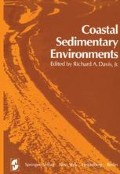Abstract
The zone where land and sea meet is composed of a variety of complex environments. The coastal areas of the world contain a large percentage of its population and are therefore of extreme economic importance. Industrial, residential, and recreational developments, as well as large urban complexes, occupy much of the coastal margin of most highly developed countries. Undoubtedly future expansion in many undeveloped maritime countries will also be concentrated on coastal areas. Accompanying our occupation of coasts in this age of technology is a dependence on coastal environments for transportation, food, water, defense, and recreation. In order to utilize the coastal zone to its capacity, and yet not plunder its resources, we must have extensive knowledge of the complex environments contained along the coasts.
Access this chapter
Tax calculation will be finalised at checkout
Purchases are for personal use only
Editor information
Editors and Affiliations
Rights and permissions
Copyright information
© 1978 Springer-Verlag, New York Inc.
About this chapter
Cite this chapter
Davis, R.A. (1978). Introduction. In: Davis, R.A. (eds) Coastal Sedimentary Environments. Springer, New York, NY. https://doi.org/10.1007/978-1-4684-0056-4_1
Download citation
DOI: https://doi.org/10.1007/978-1-4684-0056-4_1
Publisher Name: Springer, New York, NY
Print ISBN: 978-1-4684-0058-8
Online ISBN: 978-1-4684-0056-4
eBook Packages: Springer Book Archive

